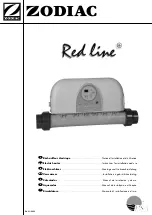
6 720 817 281 (2017/05)
Greentherm 9800 SEO 160/199 | SECO 199
30 | Maintenance and service
Heat Exchanger
•
Inspect burner observation window for cracks or spillage of
flue gases. Observe burner flames during heater operation.
Flames should be steady and blue with no signs of
yellowing. Yellow burner flames are an indication of
improper combustion. Refer to Section 4.5.1 of this
manual to verify the combustion air supply meets the
manufacturer's specifications.
Pressure Relief
•
Manually open the pressure relief valve to ensure proper
operation.
Inlet Water Filter
•
Verify the inlet water filter screen is clean and undamaged.
The inlet water filter is located on the bottom of the
appliance, to the right of the cold water inlet fitting. (See
Fig.13, page 19). Close the installer supplied water shutoff
valve and remove wireform spring clip from filter. Remove
the filter, clean and or replace if damaged.
Descaling
•
In areas where the water supply has a high mineral content,
the heat exchanger should be flushed with a descaling
solution. Scale build up will shorten the life of the water
heater and damage resulting from scale is not covered
under warranty. Refer to section9.3 for detailed
instructions on descaling the heat exchanger.
Condensate Siphon
•
Check for debris and clean if needed.
9.2
Winterizing for seasonal use
The water heater must not be installed in a location where it
may be exposed to freezing temperatures. If the heater must be
left in a space which is likely to experience freezing
temperatures, all water must be drained from the heater.
NOTE: Use of agents such as anti-freeze is not permitted and
voids the warranty, as they may cause damage to the water
heater's internal components.
1. Press ON/OFF switch on the water heater to turn OFF the
heater and unplug power supply cord. The display should
be blank.
2. Shut off gas supply to heater.
3. Shut off the water supply to the water heater using installer
supplied shutoff valve.
4. Open hot water taps to drain and relieve pressure from the
plumbing system. If water continues to flow after 5
minutes, a crossover of the hot and cold water pipes is
present and must be corrected before proceeding.
5. Disconnect the inlet and outlet water pipes from the water
heater. Place a small bucket underneath the water heater
to catch residual water remaining inside the water heater.
6. Using an air compressor, blow short bursts of air (100psi
max) through the inlet water connection until there is no
water present coming through the outlet water connection
of the heater.
7. Empty condensate trap.
8. Reconnect water fittings, refill the condensate trap and
return heater to service when danger of freezing has
passed.
9.3
Mineral scale build-up
Periodic descaling may be necessary in areas with high mineral
content in the water. Scale buildup in the heat exchanger may
result in lower flow rates, error codes of AA, E3, E5 and boiling
sounds in the heat exchanger.
A water softener is required if the water hardness exceeds 14
grains/gal (200 mg/l) calcium carbonate. Damage to the water
heater resulting from hard water/scale deposits will not be
covered under warranty.
Descaling using a pump
▶ Disconnect the electrical supply from the water heater.
▶ Shut off the water supply to the water heater using
(installer supplied) shutoff valve.
▶ Open hot water taps to drain and relieve pressure from the
plumbing system.
▶ Drain water from the unit's heat exchanger by
disconnecting inlet and outlet water connections from the
heater.
▶ Connect a line (A) from the outlet of the circulating pump
(installer supplied) to the inlet water fitting on the water
heater (see fig. 27.)
▶ Using another line (B), connect the water outlet fitting on
the water heater. Route the other end of this line into a
descaling reservoir.
▶ Using a 3rd line (C) from the descaling reservoir, connect
to the inlet side of circulating pump. Install a filter on the
end of the line in the descaling reservoir.
▶ Make sure all connections are "water tight.".
▶ Fill bucket with descaling solution so both lines inside are
submersed. We recommend a straight white vinegar
solution. If using a commercial descalant, refer to
manufacturer's instructions for proper dilution ratio.
▶ Operate the circulating pump.
▶ Make sure there are no leaks and the solution is flowing
from the descaling reservoir through the heater and
returning to the reservoir.
▶ Run the solution through the heater until the solution
returning to the descaling reservoir comes out clear.
(Changing to a fresh solution may be necessary during this
process).
















































